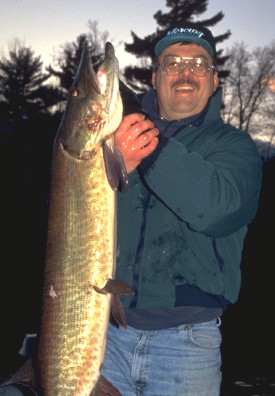 |
| Though it’s generally not considered a big fish time, Steve Heiting has caught muskies measuring as large as this 48-incher in the early season. |
Eight muskies in a day, a couple of times. Certainly several sevens. And lots of 6- and 5-fish days. A check of my fishing records for the past few years reveals a striking pattern of multiple musky days early in the season, so much so that I can say with full conviction that if you want to catch a musky, spring is the time to do it.
Sure, muskies are known as the “fish of 10,000 casts,” and at times they live up to that billing. But consider why early season muskies are easy: they’re located shallow, in predictable locations; they’re hungry; and they haven’t been pestered by musky anglers since last season closed. It’s a formula for musky success.
LOCATION, LOCATION, LOCATION
The musky spawn is triggered by water temperature and photoperiodism, and will generally occur in the middle of April in southern Wisconsin to as late as the middle of May in northern Wisconsin, when the water temperature reaches 52-55 degrees. Muskies prefer shallow, soft bottom areas, preferably with last year’s dead vegetation, for spawning. These areas become better if they’re located on the north side of the lake (more direct sunlight will warm the water faster), and if a stream enters the lake nearby.
Muskies are protected while spawning to ensure their reproductive success. Thus, musky season south of Wisconsin’s Highway 10 opens with the general fishing opener on the first Saturday in May. North of Highway 10, the season opens the Saturday of Memorial Day weekend.
During cold springs, fish can still be in their spawning areas when the season opens. A warm spring will hasten the spawn and muskies will have moved out to what are commonly called “transition” areas — logs, islands, weedbeds, points, rock humps, docks, boathouses, anything that can provide cover and is located near the spawning areas, but not in the main lake.
THEY’LL TELL YOU WHAT THEY WANT
Since muskies will still be in shallow water, a presentation that can be fished slowly in these locations is ideal. If the water temperature on opening day is less than 60 degrees, I use chubs and small suckers as bait with a medium-weight spinning rig. Lip-hook a 5- to 7-inch baitfish, cast it out and let it settle for a moment. Then crank your reel handle 3-4 times, pause, crank 3-4 times, pause, all the way to the boat.
Each time you crank, the baitfish will scoot forward, and on the pause it will sink slowly. It doesn’t matter if the bait is live or dead, because you impart the action. Strikes usually occur during the pause, and may feel like a walleye hitting a jig, or just weight on the line. If you feel anything out of the ordinary, count to 10 and set the hook. The 10-count prevents the musky from swallowing the bait and being hooked deeply. And setting on anything will keep you from thinking you’ve hung up on a weed and not setting the hook on what proves to be a musky.
Medium-weight spinning rods are essential because a 5- to 7-inch baitfish is too light to cast with conventional musky gear. It takes time and patience to battle a musky on this equipment, but I’ve caught them up to 48 inches doing this so it can be done.
Though I start with livebait, I read the muskies’ mood and switch to conventional gear if they’re aggressive. Twitchbaits, like the Bucher Baby ShallowRaider or the 5- or 6-inch Slammers, are ideal. Seven-inch Suicks and small Eddie Baits, or spinners like Rizzo Wizzes or Baby Bootails are great for this shallow water situation. Don’t rule out a large glider, such as the 8-inch Eddie or Reef Hawg, which may tempt a big, spawned-out female.
Early season muskies are predictable, easy, and can be caught in bunches. Don’t overlook this little known musky prime time. |